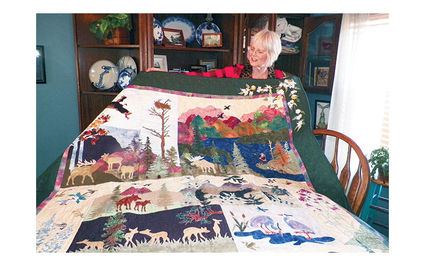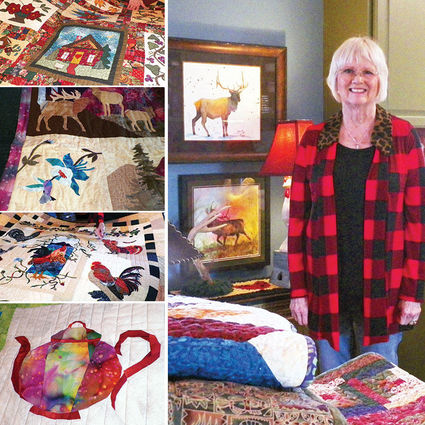Love, joy, friendship and quilts
• Quilter extraordinaire Carolyn Demaree celebrates life through quilts
February 9, 2020

Kathleen Lourde
This art quilt, called "At Home In the Woods," has won ribbons in Oklahoma and Kansas. "It's a bit of a monster," Carolyn Demaree said, laughing. It features complex appliques and embroidery. "Just the little hummingbird has nine pieces to it," she said.
Most people who doodle while talking on the phone draw things like stick figures or mindless scribbles on a notepad.
Carolyn Demaree's doodle is just a bit different. It's a quilt.
"Everybody has a doodle," said Demaree, 77. "You know, for while you're talking on the phone. This is my doodle. I hand-quilted it and put a bird up here and a heart down here."
Demaree has made several hundred quilts. "They call me a manufactory," she said, chuckling.
"Everybody asks why I have so many, and I say, because ... well, I've got 15 grandkids and 17 great-grandkids, and my side of the family hasn't even started! My son's got a new home and a lot are going to his place. So eventually they'll have a place to go to."
Some time ago she went through a period of feeling she should stop making so many quilts, and got a little despondent. But her daughter told her, "Mom, you know we're all gonna fight over them when you're gone, so just keep making them."
And she has.
Well, it was a foregone conclusion, really. Her quilts are like members of her family. "I just love them," she said. "They're like my family."
As photos were taken of many of her quilts in preparation for this story, Demaree burst out, "They're so happy they're getting their picture taken!"
The Difference a Good Friend Makes
Demaree's lifelong friend, Connie Allen, got her into quilting.
"Connie ran Quilter's Depot in Waynoka with a couple friends. Connie and I were friends all our life, and we graduated together in 1960. And we had this joke that whoever dies first gets the other's stash. She passed away a year ago or so, and she left me her stash."
In the spirit of that friendship, Demaree will often give away cloth from that stash.
Demaree made her first quilt with Allen. They bought a pattern in Enid, and then, when Demaree started to lose steam for the project, Allen showed up at her place and said "Come on. You cut, and I'll press."
That first quilt, with a log cabin pattern, is made up of countless tiny strips. It was more difficult than Demaree may have anticipated, but it looks just as professional as the rest of her quilts, and it has a special place in her heart.
In the years since that first quilt, Demaree's textile talents have flourished exponentially.
Demaree has at least three work rooms, and it's a good thing because she is an incredibly prolific quilter, an exceptional painter using a wide variety of techniques, a rug puncher and rug weaver, a jewelry maker, beader, basket maker ... the list likely could go on for pages. She also teaches her many skills to others.
Her biggest studio is a mobile home across the driveway from her house north of Alva. The main area is taken up with a 14-foot table where she teaches quilting. The storage rooms are filled to bursting with what Demaree calls her stash – cloth of every conceivable color, pattern and texture; ribbons, lace, beads; and the walls are hung with tools of the trade, like her self-sealing cutting knife that you simply roll across a piece of fabric to cleanly slice through it.
But her most important work might be said to take place out in the community.
Creating a Quilting Community
Allen and Demaree started the Peace by Piece Quilt Guild six or seven years ago, Demaree said.
"Connie and I started it, and there was a whole bunch of interest, and people started coming," she said. "Connie was good at organizing, so she got us our bylaws and all that sort of stuff. But she had health issues, so I'd take over and run it and we'd work together like that. Then another president came in, and now I'm on my second time as president."
The meetings, held on the third Tuesday of the month, consist of a program featuring an aspect of quilting and refreshments. They often have a speaker from another guild, and Demaree is hoping to help expand members' skills by getting someone in to teach crochet, knitting, and embroidery – all of which can be used in making a quilt.
"Some girls have their own long-arm quilting machines who can do the quilting for other people, so we really have it together. We just have to keep the interest going."
The club is well known for the many Quilts of Valor it has presented to veterans in Woods County. The group has presented 130 such quilts so far and has another 12 planned for this year.
The quilts are often treasured by those who receive them.
"Some of them use those quilts on their caskets – it meant so much to them that it meant a lot to the families," said Demaree. "One of the World War II guys, he said, 'This means more to me than anything else because it came to me from people, not from the service.'
"And I've had them come up to me just wherever I'm at and they've said to me, 'That was the greatest thing you ever did.' One lady told me (of her husband, who had received a Quilt of Valor), 'He has never talked about this experience until he got this quilt, and it has been the best thing in the world for him. He kind of had shell shock, PTSD, and never said anything. When he got this, you won't believe the change in him.' It could almost bring you to tears, the stories about how much it means to them," she said. "It's a real rewarding thing to do."
Public Service Quilts
In fact, quilts have often been a means by which the ladies of the house could make the world outside their doors a little better.
In the old days, quilts weren't only for warmth, they were also used for messages, said Demaree.
Quilts were hung on a clothesline, and a block of a certain color, say, would tell travelers without much money – immigrants, escaped slaves, hobos or others – that a free meal could be had at that house, for example, or a place to sleep, or that it would be dangerous for them to stop.
And then again, sometimes quilts have been status symbols for the man of the house.
Demaree displayed what she called a piano quilt – a heavily worked small crazy quilt, made with the satin, fringe and fanciness of a traditional piano shawl.
"These came up from the more utilitarian ones. Home folks like us on the farms, they used leftover items in their stash of clothing for quilts," she said.
"But the more aristocratic people, even though she had to take care of the kids, plow the field, make the food, she also had to make him look good by making one of these wonderful crazy quilts to display, and that was your uppityness."
She looked down at the crazy quilt in her hands and laughed. "And this is my uppityness, I guess!"
The Value of Quilts
Gauging the value of a quilt, particularly an old quilt, can be difficult. Generally, it needs documentation of some kind – an award from a show or a photograph of Granny quilting that very quilt – something to prove its age and maker.
But quilts can't be valued only in terms of money.
"The pride of having an antique quilt that comes from your history or ancestors – that is mainly personal," Demaree said.

Kathleen Lourde
Right: Carolyn Demaree stands amid some of her creations, including not only the quilts on the table in front of her, but also the paintings on the wall beside her. Photo by Kathleen Lourde Left top: This quilt, called Seasons of My Life, will go to her daughter, Demaree said. Throughout it are blocks that refer to times in their family's life. A little block with an embroidered elk represents the 77 elk the family raised. "This block is my flaming youth," said Demaree, laughing, "and this one is me overcoming it!" Left, second from top: The hummingbird alone is made up of nine separate pieces. Left, third from top: Demaree made this rooster quilt using a needle-turn applique technique. Left, bottom: This is a detail from a quilt that was paper-pieced -- a difficult technique that Demaree has clearly mastered. Each teacup or teapot is made up of countless tiny seams sewn with even tinier stitches.
And that's true of new quilts as well, of course. Demaree motioned toward one of her quilts. "This one I hand quilted. It has my granddaughter's first dress in there; some of the fabrics are there because we raised elk; in and around here are things about my family. You memorialize. When we had kids, we sewed for them and they're gone." But in a quilt you can keep bits of the children's favorite clothes, and your family for generations to come, hopefully, will know that that bit of cloth came from their mother's or grandmother's first dress.
They can be pricey to make, though.
"Not all quilts are made out of rags," said Demaree. "The cost of the yard of fabric is anywhere from $10 to $12 to $15. Then you've got five to 20 yards in a quilt. And they sell them at the auction for pennies."
But just because they're expensive to make doesn't mean they need to be babied, said Demaree.
"Quilts like to be shoved around and messed around with. When you fold a quilt up, you don't want it to be straight up, straight down, and make creases. You actually want to wad it as much as you can, pull it out after six months, then wad it up again. Refold it in a different spot each time so you don't get permanent creases," she said. "Fabric is tough; you don't baby it."
Well, it could be Demaree's skill that makes them so tough, couldn't it? Especially when she puts her whole heart and soul into every single stitch.
"You know, I always try to think wonderful thoughts and not be angry when I deal with fabric because I think it retains those emotions. Well, it probably does not, but I think maybe it does," she said and, as she'd been doing all day, threw her head back and laughed.











Reader Comments(0)